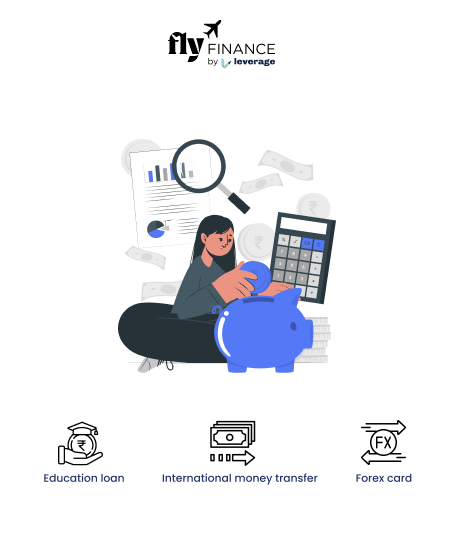When planning to study abroad, one of the primary concerns for Indian students is financing their education. Tuition fees often take centre stage, but living expenses, including accommodation, food, transportation, and other necessities, also comprise a significant budget. So, a common question arises: Does an education loan cover living expenses?
The answer is yes and the good news is that most education loans available to international students do cover living expenses, provided certain conditions are met. Let’s check and explore how education loans work in this context, what they cover, and tips to make the most of your loan.
Table of contents
Does Education Loan Cover Living Expenses?
Most education loans offered by banks and financial institutions cover living expenses. It is one of the primary expenses that are covered by the loan. You can pay monthly rent, advances, security deposits, parking charges etc by the loan amount. The bank may transfer the amount directly to the university if you have opted for university accommodation.
Also Read: Compare the education loan interest rates of different lenders and avail study abroad education loans at the lowest interest rates in 2024
What Do Education Loans Cover?
Education loans for students are designed to cover a wide range of expenses beyond just tuition fees. These typically include living costs such as accommodation, food, and daily essentials, as well as travel expenses like airfare and local transportation. Student loans may cover costs for study materials, including books and laptops, along with health or student travel insurance for abroad. Some loans also account for other one-time charges, such as lab fees or exam costs, ensuring comprehensive financial support for students pursuing education abroad. Check the type of expenses covered by education loans below:
- Tuition Fees: The primary component of an education loan is the payment for academic fees.
- Living Expenses: This includes costs for accommodation, food, and daily living needs.
- Travel Costs: Expenses related to airfare or local transportation.
- Books and Study Materials: Expenses for textbooks, e-books, and other course materials.
- Insurance: Some loans also cover health and travel insurance.
- Other Costs: Such as laptop purchases, lab fees, or other one-time charges.
How Much Can You Borrow for Living Expenses?
Education loans typically cover living expenses in proportion to the cost of living in the destination country. For example:
- In the USA, students may need USD 1,000-1,500 per month.
- In European countries, the range is often EUR 700-1,200 monthly.
- For countries like Australia or Canada, monthly costs can vary between AUD 1,200-1,500 or CAD 1,000-1,500.
Banks usually calculate this amount based on university-provided cost estimates and the applicant’s financial needs.
Also Read: Check out the FAQs on the Restructuring 2.0 Scheme of RBI that provides benefits to the borrowers affected by the COVID-19 pandemic.
Factors to Consider While Applying for an Education Loan
When applying for an education loan, it’s essential to consider factors like the loan amount, ensuring it adequately covers tuition and living expenses. Compare interest rates and repayment terms across banks and NBFCs to find the best deal. Check for a moratorium period that allows repayment to begin after completing your course.
- Loan Limit: Ensure the loan limit covers both tuition and your estimated living expenses.
- Country-Specific Guidelines: Some banks set specific caps depending on the country you’re travelling to.
- Interest Rates: Compare interest rates across banks and NBFCs (Non-Banking Financial Companies).
- Moratorium Period: Look for loans offering a repayment-free period during your course.
- Proof of Expenses: Banks often ask for a breakdown of expected costs; ensure you present accurate estimates.
Education loans often cover living expenses, making it easier for you to focus on your studies without financial stress. However, it’s crucial to thoroughly research loan terms and conditions to avoid surprises later. Check some common FAQs based on the same below:
FAQs
Yes, most education loans cover living expenses, including accommodation, food, and daily essentials, in addition to tuition fees and other academic costs.
Living expenses typically include housing, meals, transportation, utility bills, and personal costs. Some loans may also cover health insurance and travel.
Banks estimate living expenses based on the cost of living in the destination country, often using data provided by the university or local benchmarks.
Yes, limits are based on the country, university, and total loan amount sanctioned. Ensure the loan sufficiently covers your estimated expenses.
Absolutely! Loans cover all types of accommodation, including university dormitories, rented apartments, or shared housing arrangements.
Yes, banks often require a detailed cost breakdown, such as university-provided estimates or receipts for pre-booked accommodation.
Part-time jobs are optional but can help reduce financial stress by covering additional costs not included in the loan. Check visa work regulations.
Many education loans include airfare as part of the overall sanctioned amount, typically for a one-way ticket to your destination.
Yes, scholarships can complement education loans, reducing the total amount you need to borrow and easing repayment later.
Repayment usually starts after the moratorium period, which often lasts until the completion of your course plus 6-12 months.
To know more about education loans, the best bank accounts for students, forex and banking experience for global students or international money transfers, reach out to our experts at 1800572126 to help ease your study abroad experience.





























